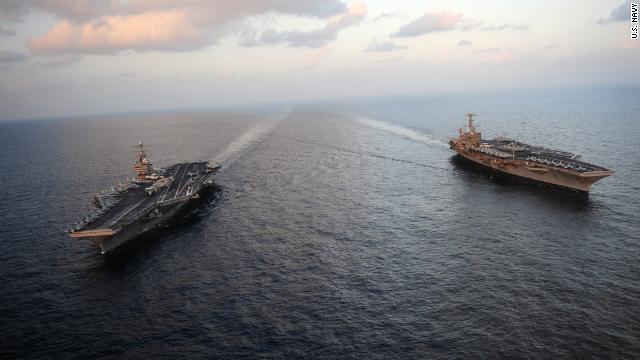After Iran threat, U.S. aircraft carrier goes through Strait of Hormuz without incident
January 23, 2012 -- Updated 0404 GMT (1204 HKT)

The USS Abraham Lincoln and the USS John Stennis are in the Gulf. The Lincoln moved through the Strait of Hormuz Sunday.
(CNN) -- Flanked by British and French ships, the USS Abraham Lincoln aircraft carrier moved through the Strait of Hormuz without incident Sunday despite recent threats from Iran.
The U.S. Naval Forces Central Command said in a statement that the Lincoln "completed a regular and routine transit of the strait ... to conduct maritime security operations." The Lincoln is in the region with the USS Carl Vinson, giving the U.S. Navy its standard two-carrier presence there.
-
A British defense ministry spokesman, who was not named per policy, said Sunday that the "HMS Argyll and a French vessel joined a U.S. carrier group" going through the strait "to underline the unwavering international commitment to maintaining rights of passage under international law."
"Britain maintains a constant presence in the region as part of our enduring contribution to Gulf security," the spokesman said.
Several weeks ago, as the USS John Stennis left the Persian Gulf and headed back to the western Pacific, Iranian officials warned the United States not to send in another carrier.
-
"We have always stated that there is no need for the forces belonging to the countries beyond this region to have a presence in the Persian Gulf," Brig. Gen. Ahmad Vahidi said in early January, according to the semi-official Fars News Agency. "Their presence does nothing but create mayhem, and we never wanted them to be present in the Persian Gulf."
-
Tehran has threatened to close the Strait of Hormuz, the only outlet to and from the Persian Gulf between Iran and the United Arab Emirates as well as Oman, as Iran faces increased scrutiny over its nuclear program and possible sanctions on its oil exports. The critical shipping lane had 17 million barrels of oil per day passing through in 2011, according to the U.S. Energy Information Agency.
-
U.S. Defense Secretary Leon Panetta has responded by threatening to "respond" if Iran attempts to shut down traffic. He said that the U.S. naval and military presence in the region will not change and the current level is sufficient to deal with any situation that could arise.
-
"We have always maintained a very strong presence in that region," Panetta said earlier this month. "We have a Navy fleet located there. We have a military presence in that region. And ... we have continually maintained a strong presence in the region to make very clear that we were going to do everything possible to help secure the peace in that part of the world.-
No comments:
Post a Comment